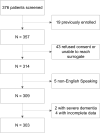Delirium in older emergency department patients: recognition, risk factors, and psychomotor subtypes
- PMID: 19154565
- PMCID: PMC5015887
- DOI: 10.1111/j.1553-2712.2008.00339.x
Delirium in older emergency department patients: recognition, risk factors, and psychomotor subtypes
Abstract
Objectives: Missing delirium in the emergency department (ED) has been described as a medical error, yet this diagnosis is frequently unrecognized by emergency physicians (EPs). Identifying a subset of patients at high risk for delirium may improve delirium screening compliance by EPs. The authors sought to determine how often delirium is missed in the ED and how often these missed cases are detected by admitting hospital physicians at the time of admission, to identify delirium risk factors in older ED patients, and to characterize delirium by psychomotor subtypes in the ED setting.
Methods: This cross-sectional study was a convenience sample of patients conducted at a tertiary care, academic ED. English-speaking patients who were 65 years and older and present in the ED for less than 12 hours at the time of enrollment were included. Patients were excluded if they refused consent, were previously enrolled, had severe dementia, were unarousable to verbal stimuli for all delirium assessments, or had incomplete data. Delirium status was determined by using the Confusion Assessment Method for the Intensive Care Unit (CAM-ICU) administered by trained research assistants (RAs). Recognition of delirium by emergency and hospital physicians was determined from the medical record, blinded to CAM-ICU status. Multivariable logistic regression was used to identify independent delirium risk factors. The Richmond Agitation and Sedation Scale was used to classify delirium by its psychomotor subtypes.
Results: Inclusion and exclusion criteria were met in 303 patients, and 25 (8.3%) presented to the ED with delirium. The vast majority (92.0%, 95% confidence interval [CI] = 74.0% to 99.0%) of delirious patients had the hypoactive psychomotor subtype. Of the 25 patients with delirium, 19 (76.0%, 95% CI = 54.9% to 90.6%) were not recognized to be delirious by the EP. Of the 16 admitted delirious patients who were undiagnosed by the EPs, 15 (93.8%, 95% CI = 69.8% to 99.8%) remained unrecognized by the hospital physician at the time of admission. Dementia, a Katz Activities of Daily Living (ADL) < or = 4, and hearing impairment were independently associated with presenting with delirium in the ED. Based on the multivariable model, a delirium risk score was constructed. Dementia, Katz ADL < or = 4, and hearing impairment were weighed equally. Patients with higher risk scores were more likely to be CAM-ICU positive (area under the receiver operating characteristic [ROC] curve = 0.82). If older ED patients with one or more delirium risk factors were screened for delirium, 165 (54.5%, 95% CI = 48.7% to 60.2%) would have required a delirium assessment at the expense of missing 1 patient with delirium, while screening 141 patients without delirium.
Conclusions: Delirium was a common occurrence in the ED, and the vast majority of delirium in the ED was of the hypoactive subtype. EPs missed delirium in 76% of the cases. Delirium that was missed in the ED was nearly always missed by hospital physicians at the time of admission. Using a delirium risk score has the potential to improve delirium screening efficiency in the ED setting.
Figures
References
-
- Sanders AB. Missed delirium in older emergency department patients: a quality-of-care problem. Ann Emerg Med. 2002;39:338–341. - PubMed
-
- Hustey FM. The use of a brief depression screen in older emergency department patients. Acad Emerg Med. 2005;12:905–908. - PubMed
-
- Ely EW, Shintani A, Truman B, et al. Delirium as a predictor of mortality in mechanically ventilated patients in the intensive care unit. JAMA. 2004;291:1753–1762. - PubMed
-
- McCusker J, Cole M, Abrahamowicz M, Primeau F, Belzile E. Delirium predicts 12-month mortality. Arch Intern Med. 2002;162:457–463. - PubMed
-
- Kakuma R, du Fort GG, Arsenault L, et al. Delirium in older emergency department patients discharged home: effect on survival. J Am Geriatr Soc. 2003;51:443–450. - PubMed
Publication types
MeSH terms
Grants and funding
LinkOut - more resources
Full Text Sources
Medical
Miscellaneous



